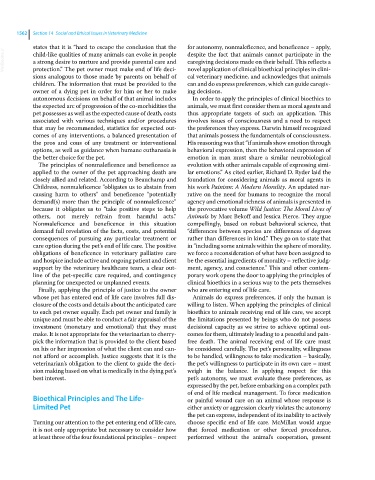Page 1624 - Clinical Small Animal Internal Medicine
P. 1624
1562 Section 14 Social and Ethical Issues in Veterinary Medicine
states that it is “hard to escape the conclusion that the for autonomy, nonmaleficence, and beneficence – apply,
VetBooks.ir child‐like qualities of many animals can evoke in people despite the fact that animals cannot participate in the
caregiving decisions made on their behalf. This reflects a
a strong desire to nurture and provide parental care and
protection.” The pet owner must make end of life deci-
cal veterinary medicine, and acknowledges that animals
sions analogous to those made by parents on behalf of novel application of clinical bioethical principles in clini-
children. The information that must be provided to the can and do express preferences, which can guide caregiv-
owner of a dying pet in order for him or her to make ing decisions.
autonomous decisions on behalf of that animal includes In order to apply the principles of clinical bioethics to
the expected arc of progression of the co‐morbidities the animals, we must first consider them as moral agents and
pet possesses as well as the expected cause of death, costs thus appropriate targets of such an application. This
associated with various techniques and/or procedures involves issues of consciousness and a need to respect
that may be recommended, statistics for expected out- the preferences they express. Darwin himself recognized
comes of any interventions, a balanced presentation of that animals possess the fundamentals of consciousness.
the pros and cons of any treatment or interventional His reasoning was that “if animals show emotion through
options, as well as guidance when humane euthanasia is behavioral expression, then the behavioral expression of
the better choice for the pet. emotion in man must share a similar neurobiological
The principles of nonmaleficence and beneficence as evolution with other animals capable of expressing simi-
applied to the owner of the pet approaching death are lar emotions.” As cited earlier, Richard D. Ryder laid the
closely allied and related. According to Beauchamp and foundation for considering animals as moral agents in
Childress, nonmaleficence “obligates us to abstain from his work Painism: A Modern Morality. An updated nar-
causing harm to others” and beneficence “potentially rative on the need for humans to recognize the moral
demand(s) more than the principle of nonmaleficence” agency and emotional richness of animals is presented in
because it obligates us to “take positive steps to help the provocative volume Wild Justice: The Moral Lives of
others, not merely refrain from harmful acts.” Animals by Marc Bekoff and Jessica Pierce. They argue
Nonmaleficence and beneficence in this situation compellingly, based on robust behavioral science, that
demand full revelation of the facts, costs, and potential “differences between species are differences of degrees
consequences of pursuing any particular treatment or rather than differences in kind.” They go on to state that
care option during the pet’s end of life care. The positive in “including some animals within the sphere of morality,
obligations of beneficence in veterinary palliative care we force a reconsideration of what have been assigned to
and hospice include active and ongoing patient and client be the essential ingredients of morality – reflective judg-
support by the veterinary healthcare team, a clear out- ment, agency, and conscience.” This and other contem-
line of the pet‐specific care required, and contingency porary work opens the door to applying the principles of
planning for unexpected or unplanned events. clinical bioethics in a serious way to the pets themselves
Finally, applying the principle of justice to the owner who are entering end of life care.
whose pet has entered end of life care involves full dis- Animals do express preferences, if only the human is
closure of the costs and details about the anticipated care willing to listen. When applying the principles of clinical
to each pet owner equally. Each pet owner and family is bioethics to animals receiving end of life care, we accept
unique and must be able to conduct a fair appraisal of the the limitations presented by beings who do not possess
investment (monetary and emotional) that they must decisional capacity as we strive to achieve optimal out-
make. It is not appropriate for the veterinarian to cherry‐ comes for them, ultimately leading to a peaceful and pain‐
pick the information that is provided to the client based free death. The animal receiving end of life care must
on his or her impression of what the client can and can- be considered carefully. The pet’s personality, willingness
not afford or accomplish. Justice suggests that it is the to be handled, willingness to take medication – basically,
veterinarian’s obligation to the client to guide the deci- the pet’s willingness to participate in its own care – must
sion making based on what is medically in the dying pet’s weigh in the balance. In applying respect for this
best interest. pet’s autonomy, we must evaluate these preferences, as
expressed by the pet, before embarking on a complex path
of end of life medical management. To force medication
Bioethical Principles and The Life‐ or painful wound care on an animal whose response is
Limited Pet either anxiety or aggression clearly violates the autonomy
the pet can express, independent of its inability to actively
Turning our attention to the pet entering end of life care, choose specific end of life care. McMillan would argue
it is not only appropriate but necessary to consider how that forced medication or other forced procedures,
at least three of the four foundational principles – respect performed without the animal’s cooperation, present

